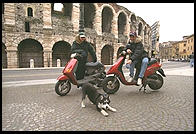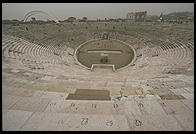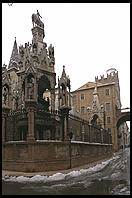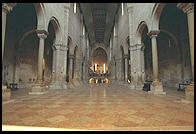
 The biggest sight of downtown Verona is the Arena, which is a lot like Rome's
Colosseum except that the popes didn't use it for a quarry. Almost perfectly
preserved, it is the third largest Roman amphitheatre extant, after the Colosseum
and the one in Capua, near Naples (I've never seen this last one, but Italians
say it is the most interesting because the mechanisms used for raising animals
into the arena are still functional).
The biggest sight of downtown Verona is the Arena, which is a lot like Rome's
Colosseum except that the popes didn't use it for a quarry. Almost perfectly
preserved, it is the third largest Roman amphitheatre extant, after the Colosseum
and the one in Capua, near Naples (I've never seen this last one, but Italians
say it is the most interesting because the mechanisms used for raising animals
into the arena are still functional).
Built in 30 AD, the Arena was used for the usual Roman gladiatorial combats. Today it is used in July and August for an opera season that fills the 25,000 seats and all the nearby hotels. Every Christmas, the Veronese bolt a huge steel sculpture of a falling star onto the side of the Arena and stuff the basement with creches ("nativity scenes" for British readers) from around the world.
From the Arena, you can walk up Via Mazzini, Italy's very first pedestrian-only street, to the ...
Once the Roman forum, the "Square of Herbs" hosts an open-air market every day.
A block away, at Via Cappello 23, is Casa di Guilietta. In fact there is no evidence linking this former inn to Shakespeare's Juliet, but there is a fine bronze statue in the courtyard under the plausible balcony. Note that the statue's right breast, remarkably full for a girl who was just turning 14 in an age before they had hormone-injected beef, has been polished to a bright sheen by the hands of thousands of tourists. Repulsive.
Just a step through an arched portal puts you in the
This was the center of Scaligeri family life and government. In the center is a modern (1865) statue of Dante, who spent part of his exile from Florence here in Verona and who dedicated some of his works to the Scaligeri. Stop in the Caffe Dante if you want to refresh yourself in a really congenial spot.
Then walk to the other side of the square and take the elevator to the top of the Torre dei Lamberti, which will put you 84 meters above the Piazza delle Erbe. Allegedly, you'll have a great view of the Alps on a clear day, but I've no personal evidence for this fact.
 The
Scaligeri are buried just another block or so to the northeast in the Arche
Scaligere. These sarcophagi are famous works of sculpture but they are kind of
tough to get close to.
The
Scaligeri are buried just another block or so to the northeast in the Arche
Scaligere. These sarcophagi are famous works of sculpture but they are kind of
tough to get close to.
If you feel like losing some weight after seeing the tombs, walk across the street to Via Arche Scaligere 6, where you find the Ristorante Arche. First you'll lose 300,000 lire that had been making your wallet such a burden (lunch or dinner for two with wine). Then the tiny portions of incredibly delicate fish-based dishes will keep you hungry until dessert, which I thought was well worth 18,000 lire. The place has been run for more than 100 years by the Gioco family and the building may in fact be on the site of Romeo's original house.
If you planned a less costly and more filling lunch, head north two blocks to the Trattoria Santa Anastasia at Coso Santa Anastasia 27. It gets two forks in the Michelin Red Guide and you couldn't ask for friendlier service.
At this point you are mere steps from the Sant'Anastasia church. You may as well duck in to look at the famous fresco by Pisanello of St. George Delivering the Princess of Trebizond. It gets three stars in my personal guidebook for the dragon, but then loses a couple because it has been somewhat damaged since 1436.
Since you had to fork out 6,000 lire to get into Sant'Anastasia and the same ticket gets you into the Duomo, you might as well head over there to check out the Assumption by Titian. At that point, you're almost at the river so walk upstream (west) and when you see a huge castle, you've come to the
This castle was built in 1354 by Cangrande ("Big Dog") II Scaliger. It is now one of the Veneto's finest art museums and certainly the most serpentine. You climb all around the castle to see various Gothic and Renaissance treasures, often with beautiful views out over the Ponte Scaligero, the bridge that served as the castle's main entrance for 600 years until the Germans blew it up. The Veronese picked the pieces out of the river and put the bridge back together again.
If you walk for 15 minutes to the northwest, you come to
 "One of the finest Romanesque
chruches in northern Italy" (Michelin guide). The big draw is the bronze front
door, which paradoxically you can only see from the inside. The Eyewitness Guide
claims that one panel shows a woman suckling two crocodiles but I couldn't find
it.
"One of the finest Romanesque
chruches in northern Italy" (Michelin guide). The big draw is the bronze front
door, which paradoxically you can only see from the inside. The Eyewitness Guide
claims that one panel shows a woman suckling two crocodiles but I couldn't find
it.